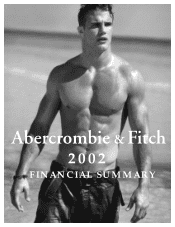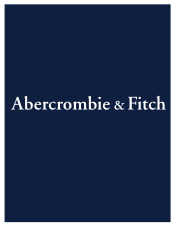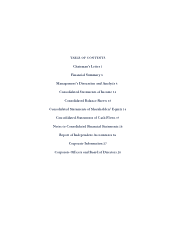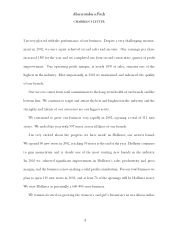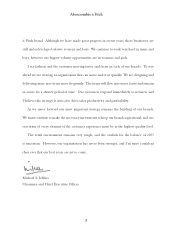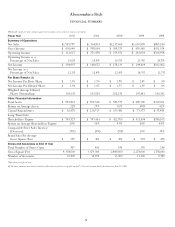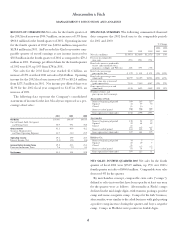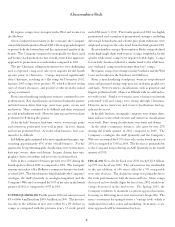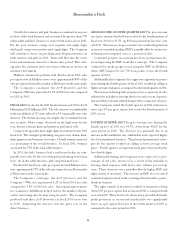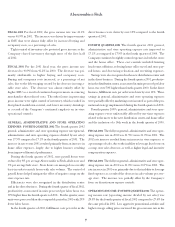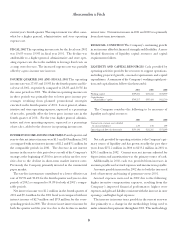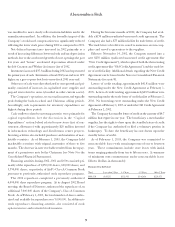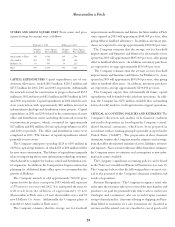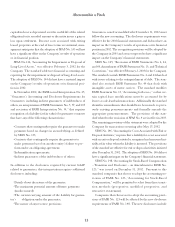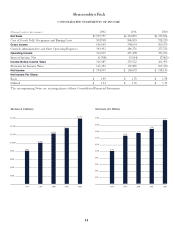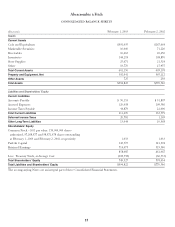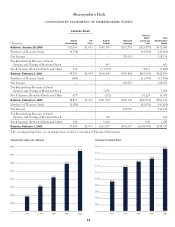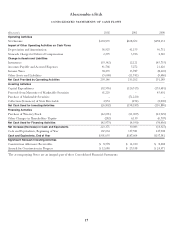Abercrombie & Fitch 2002 Annual Report Download - page 10
Download and view the complete annual report
Please find page 10 of the 2002 Abercrombie & Fitch annual report below. You can navigate through the pages in the report by either clicking on the pages listed below, or by using the keyword search tool below to find specific information within the annual report.
FISCAL 2002 For fiscal 2002, the gross income rate was 41.1%
versus 40.9% in 2001. The increase was driven by improvements
in IMU that were almost fully offset by increased buying and
occupancy costs, as a percentage of sales.
Tight control of inventory also protected gross income as the
Company chased inventory through most of the first half
of 2002.
FISCAL 2001 For the 2001 fiscal year, the gross income rate
decreased to 40.9% from 41.2% in 2000. The decrease was pri-
marily attributable to higher buying and occupancy costs.
Buying and occupancy costs increased, as a percentage of net
sales, due to the deleveraging created by the decrease in compa-
rable store sales. The decrease was almost entirely offset by
higher IMU as a result of continued improvements in sourcing
merchandise that reduced costs. The other factors in protecting
gross income were tight control of inventory, which resulted in
disciplined markdown control, and lower inventory shrinkage
as a result of the Company’s continued emphasis on in-store
operational controls.
GENERAL, ADMINISTRATIVE AND STORE OPERATING
EXPENSES: FOURTH QUARTER 2002 The fourth quarter 2002
general, administrative and store operating expense rate (general,
administrative and store operating expenses divided by net sales)
was 17.5% compared to 17.1% in the fourth quarter of 2001. The
increase in rate versus 2001 resulted primarily from an increase in
home office expenses, largely due to higher bonuses resulting
from improved financial performance.
During the fourth quarter of 2002, store payroll hours were
reduced by 9% per average Abercrombie & Fitch adult store and
3% per average kids store. Store hours are managed on a weekly
basis in order to match hours with sales volume. The control of
payroll hours helped mitigate the effect of negative comps on the
store expense rate.
Efficiencies were also recognized in the distribution center
and in the direct business. During the fourth quarter of fiscal 2002,
productivity, as measured in units processed per labor hour, was
39% higher than the fourth quarter of 2001. For the quarter, more
units were processed than the comparable period in 2001 with 20%
fewer labor hours.
In the fourth quarter of 2002, fulfillment costs per order in the
Abercrombie &Fitch
direct business were down by over 19% compared to the fourth
quarter of 2001.
FOURTH QUARTER 2001 The fourth quarter 2001 general,
administrative and store operating expense rate improved to
17.1% as compared to 17.9% in the fourth quarter of 2000. The
Company continued to tightly control expenses in both the stores
and the home office. These cost controls included limiting
headcount additions, reducing home office travel and store pay-
roll hours, and decreasing relocation and recruiting expenses.
Savings were also recognized in the new distribution center and
in the direct business. During the fourth quarter 2001, productiv-
ity in the distribution center, as measured in units processed per labor
hour, was over 50% higher than fourth quarter 2000. In the direct
business, fulfillment costs per order were down by over 10%. These
savings in general, administrative and store operating expenses
were partially offset by marketing costs incurred as part of the pro-
motional strategy implemented during the fourth quarter of 2001.
Fourth quarter 2000’s general, administrative and store oper-
ating expenses were unfavorably affected by one-time expenses
related to the move to the new distribution center and home office
and the inclusion of a 14th week in the fourth quarter of 2000.
FISCAL 2002 The full year general, administrative and store oper-
ating expense rate in 2002 was 21.5% versus 21.0% in 2001. The
2002 rate increase resulted from an increase in store expenses, as
a percentage of sales, due to the inability to leverage fixed costs on
a comp store sales decrease, as well as higher legal and incentive
compensation expenses.
FISCAL 2001 The full year general, administrative and store oper-
ating expense rate in 2001 was 21.0% versus 20.7% in 2000. The
rate increase in 2001 was primarily due to the inability to leverage
fixed expenses as a result of the decrease in sales volume per aver-
age store. The increase was partially offset by the Company’s
focus on discretionary expense controls.
OPERATING INCOME: FOURTH QUARTER 2002 The operat-
ing income rate (operating income divided by net sales) was
28.0% for the fourth quarter of fiscal 2002 compared to 27.6% for
the same period in 2001. Less aggressive promotional activities and
higher average selling prices increased the gross income rate in the
7

